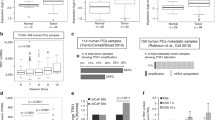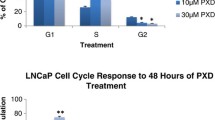Abstract
Prostate tumorigenesis is coupled with an early metabolic switch in transformed prostate epithelial cells that effectively increases their mitochondrial bioenergetic capacity. The synthetic retinoid N-(4-hydroxyphenyl)retinamide (4HPR) inhibits prostate cancer development in vivo, and triggers reactive oxygen species (ROS)-dependent prostate cancer cell apoptosis in vitro. The possibility that 4HPR-induced ROS production is associated with mitochondrial bioenergetics and required for apoptosis induction in transformed prostate epithelial cells in vitro would advocate a prospective mechanistic basis for 4HPR-mediated prostate cancer chemoprevention in vivo. We investigated this tenet by comparing and contrasting 4HPR’s effects on premalignant PWR-1E and malignant DU-145 human prostate epithelial cells. 4HPR promoted a dose- and/or time-dependent apoptosis induction in PWR-1E and DU-145 cells, which was preceded by and dependent on an increase in mitochondrial ROS production. In this regard, the PWR-1E cells were more sensitive than the DU-145 cells, and they consumed roughly twice as much oxygen as the DU-145 cells suggesting oxidative phosphorylation was higher in the premalignant cells. Interestingly, increasing the [Ca2+] in the culture medium of the PWR-1E cells attenuated their proliferation as well as their mitochondrial bioenergetic capacity and 4HPR’s cytotoxic effects. Correspondingly, the respiration-deficient derivatives (i.e., ρ0 cells lacking mitochondrial DNA) of DU-145 cells were markedly resistant to 4HPR-induced ROS production and apoptosis. Together, these observations implied that the reduction of mitochondrial bioenergetics protected PWR-1E and DU-145 cells against the cytotoxic effects of 4HPR, and support the concept that oxidative phosphorylation is an essential determinant in 4HPR’s apoptogenic signaling in transformed human prostate epithelial cells.







Similar content being viewed by others
Abbreviations
- 4HPR:
-
N-(4-Hydroxyphenyl)retinamide
- DCF:
-
2′,7′-Dichlorofluorescein
- ΔΨm :
-
Mitochondrial inner transmembrane potential
- DiOC6(3):
-
3,3′-Dihexyloxacarbocyanine iodide
- EthBr:
-
Ethidium bromide
- FITC:
-
Fluorescein isothiocyanate
- HQNO:
-
2-Heptyl-4-hydroxyquinoline-N-oxide
- KGM:
-
Keratinocyte growth medium
- Me2SO:
-
Dimethyl sulfoxide
- mtDNA:
-
Mitochondrial DNA
- NAC:
-
N-Acetyl-l-cysteine
- OXPHOS:
-
Oxidative phosphorylation
- PI:
-
Propidium iodide
- ρ0 :
-
Respiration-deficient cells lacking mtDNA
- ROS:
-
Reactive oxygen species
- SELECT:
-
Selenium and vitamin E cancer prevention trial
References
Chen JZ, Kadlubar FF (2004) Mitochondrial mutagenesis and oxidative stress in human prostate cancer. J Environ Sci Health C Environ Carcinog Ecotoxicol Rev 22:1–12
Costello LC, Franklin RB, Feng P (2005) Mitochondrial function, zinc, and intermediary metabolism relationships in normal prostate and prostate cancer. Mitochondrion 5:143–153. doi:10.1016/j.mito.2005.02.001
Sun SY, Hail N Jr, Lotan R (2004) Apoptosis as a novel target for cancer chemoprevention. J Natl Cancer Inst 96:662–672
Bettuzzi S, Brausi M, Rizzi F, Castagnetti G, Peracchia G, Corti A (2006) Chemoprevention of human prostate cancer by oral administration of green tea catechins in volunteers with high-grade prostate intraepithelial neoplasia: a preliminary report from a one-year proof-of-principle study. Cancer Res 66:1234–1240. doi:10.1158/0008-5472.CAN-05-1145
Hail N Jr, Kim HJ, Lotan R (2006) Mechanisms of fenretinide-induced apoptosis. Apoptosis 11:1677–1694. doi:10.1007/s10495-006-9289-3
Pollard M, Luckart PH, Sporn MB (1991) Prevention of primary prostate cancer by N-4-hydroxyphenyl retinamide. Cancer Res 51:3610–3611
Pienta KJ, Nguyen NM, Lehr JE (1993) Treatment of prostate cancer in the rat with the synthetic retinoid fenretinide. Cancer Res 53:224–226
Shaker MR, Yang G, Timme TL et al (2000) Dietary 4-HPR suppresses the development of bone metastasis in vivo in a mouse model of prostate cancer progression. Clin Exp Metastasis 18:429–438. doi:10.1023/A:1010905309570
Hursting SD, Shen JC, Sun XY, Wang TT, Phang JM, Perkins SN (2002) Modulation of cyclophilin gene expression by N-4-(hydroxyphenyl)retinamide: association with reactive oxygen species generation and apoptosis. Mol Carcinog 33:16–24. doi:10.1002/mc.10020
Sun S-Y, Yue P, Lotan R (1999) Induction of apoptosis by N-(4-hydroxyphenyl)retinamide and its association with reactive oxygen species, nuclear retinoic acid receptors, and apoptosis related genes in human prostate carcinoma cells. Mol Pharmacol 55:403–410
Hsieh TC, Wu JM (1997) Effects of fenretinide (4-HPR) on prostate LNCaP cell growth, apoptosis, and prostate-specific gene expression. Prostate 33:97–104. doi:10.1002/(SICI)1097-0045(19971001)33:2<97::AID-PROS3>3.0.CO;2-J
Dakubo GD, Parr RL, Costello LC, Franklin RB, Thayer RE (2006) Altered metabolism and mitochondrial genome in prostate cancer. J Clin Pathol 59:10–16. doi:10.1136/jcp.2005.027664
Serkova NJ, Gamito EJ, Jones RH et al (2008) The metabolites citrate, myo-inositol, and spermine are potential age-independent markers of prostate cancer in human expressed prostatic secretions. Prostate 68:620–628. doi:10.1002/pros.20727
Petros JA, Baumann AK, Ruiz-Pesini E et al (2005) mtDNA mutations increase tumorigenicity in prostate cancer. Proc Natl Acad Sci USA 102:719–724. doi:10.1073/pnas.0408894102
Venkataraman S, Jiang X, Weydert C et al (2005) Manganese superoxide dismutase overexpression inhibits the growth of androgen-independent prostate cancer cells. Oncogene 24:77–89. doi:10.1038/sj.onc.1208145
Ramanathan A, Wang C, Schreiber SL (2005) Perturbational profiling of a cell-line model of tumorigenesis by using metabolic measurements. Proc Natl Acad Sci USA 26:5992–5997. doi:10.1073/pnas.0502267102
Hail N Jr, Cortes M, Drake EN, Spallholz JE (2008) Cancer chemoprevention: a radical perspective. Free Radic Biol Med 45:97–110. doi:10.1016/j.freeradbiomed.2008.04.004
Hail N Jr, Lotan R (2001) Mitochondrial respiration is uniquely associated with the prooxidant and apoptotic effects of N-(4-hydroxyphenyl)retinamide. J Biol Chem 276:45614–45621. doi:10.1074/jbc.M106559200
Hail N Jr, Lotan R (2000) Mitochondrial permeability transition is a central coordinating event in N-(4-hydroxyphenyl)retinamide-induced apoptosis. Cancer Epidemiol Biomarkers Prev 9:1293–1301
Deep G, Oberlies NH, Kroll DJ, Agarwal R (2008) Isosilybin B causes androgen receptor degradation in human prostate carcinoma cells via PI3 K-Akt-Mdm2-mediated pathway. Oncogene 27:3986–3998. doi:10.1038/onc.2008.45
Hail N Jr, Youssef EM, Lotan R (2001) Evidence supporting a role for mitochondrial respiration in apoptosis induction by the synthetic retinoid CD437. Cancer Res 61:6698–6702
Hail N Jr (2008) Mitochondrial reactive oxygen species affect sensitivity to curcumin-induced apoptosis. Free Radic Biol Med 44:1382–1393. doi:10.1016/j.freeradbiomed.2007.12.034
Pique M, Barragan M, Dalmau M, Bellosillo B, Pons G, Gil J (2000) Aspirin induces apoptosis through mitochondrial cytochrome c release. FEBS Lett 480:193–196. doi:10.1016/S0014-5793(00)01922-0
Zeng Z, Samudio IJ, Zhang W et al (2006) Simultaneous inhibition of PDK1/AKT and Fms-like tyrosine kinase 3 signaling by a small-molecule KP372–1 induces mitochondrial dysfunction and apoptosis in acute myelogenous leukemia. Cancer Res 66:3737–3746. doi:10.1158/0008-5472.CAN-05-1278
Webber MM, Bello D, Kleinman HK, Wartinger DD, Williams DE, Rhim JS (1996) Prostate specific antigen and androgen receptor induction and characterization of an immortalized adult human prostatic epithelial cell line. Carcinogenesis 17:1641–1646. doi:10.1093/carcin/17.8.1641
Hail N Jr, Carter BZ, Konopleva M, Andreeff M (2006) Apoptosis effectors mechanisms: a requiem performed in different keys. Apoptosis 11:889–904. doi:10.1007/s10495-006-6712-8
Boya P, Morales MC, Gonzalez-Polo RA et al (2003) The chemopreventive agent N-(4-hydroxyphenyl)retinamide induces apoptosis through a mitochondrial pathway regulated by proteins from the Bcl-2 family. Oncogene 22:6220–6230. doi:10.1038/sj.onc.1206827
Cuello M, Coats AO, Darko I et al (2004) N-(4-hydroxyphenyl) retinamide (4HPR) enhances TRAIL-mediated apoptosis through enhancement of a mitochondrial-dependent amplification loop in ovarian cancer cell lines. Cell Death Differ 11:527–541. doi:10.1038/sj.cdd.4401387
Hail N Jr (2005) Mitochondria: a novel target for the chemoprevention of cancer. Apoptosis 10:687–705. doi:10.1007/s10495-005-0792-8
Suzuki S, Higuchi M, Proske RJ, Oridate N, Hong WK, Lotan R (1999) Implication of mitochondria-derived reactive oxygen species, cytochrome c and caspase-3 in N-(4-hydroxyphenyl)retinamide-induced apoptosis in cervical carcinoma cells. Oncogene 18:6380–6387. doi:10.1038/sj.onc.1203024
Lee HC, Wei YH (2005) Mitochondrial biogenesis and mitochondrial DNA maintenance of mammalian cells under oxidative stress. Int J Biochem Cell Biol 37:822–834. doi:10.1016/j.biocel.2004.09.010
Turrens JF (2003) Mitochondrial formation of reactive species. J Physiol 522:335–344. doi:10.1113/jphysiol.2003.049478
Zhuang S, Ouedraogo GD, Kochevar IE (2003) Downregulation of epidermal growth factor receptor signaling by singlet oxygen through activation of caspase-3 and protein phosphatases. Oncogene 22:4413–4424. doi:10.1038/sj.onc.1206604
Dalrymple S, Antony L, Xu Y et al (2005) Role of notch-1 and E-cadherin in the differential response to calcium in culturing normal versus malignant prostate cells. Cancer Res 65:9269–9279. doi:10.1158/0008-5472.CAN-04-3989
Chaproniere DM, McKeehan WL (1986) Serial culture of single adult human prostatic epithelial cells in serum-free medium containing low calcium and a new growth factor from bovine brain. Cancer Res 46:819–824
Tamiji S, Beauvillain JC, Mortier L et al (2005) Induction of apoptosis-like mitochondrial impairment triggers antioxidant and Bcl-2-dependent keratinocyte differentiation. J Invest Dermatol 125:647–658. doi:10.1111/j.0022-202X.2005.23885.x
You KR, Wen J, Lee ST, Kim DG (2002) Cytochrome c oxidase subunit III: a molecular marker for N-(4-hydroxyphenyl)retinamide-induced oxidative stress in hepatoma cells. J Biol Chem 277:3870–3877. doi:10.1074/jbc.M109284200
Garaventa A, Luksch R, Lo Piccolo MS et al (2003) Phase I trial and pharmacokinetics of fenretinide in children with neuroblastoma. Clin Cancer Res 9:2032–2039
Maurer BJ, Kalous O, Yesair DW et al (2007) Improved oral delivery of N-(4-hydroxyphenyl)retinamide with a novel LYM-X-SORB organized lipid complex. Clin Cancer Res 13:3079–3086. doi:10.1158/1078-0432.CCR-06-1889
Kadara H, Tahara E, Kim HJ, Lotan D, Myers J, Lotan R (2008) Involvement of Rac in fenretinide-induced apoptosis. Cancer Res 68:4416–4423. doi:10.1158/0008-5472.CAN-08-0031
Litvinov JVGDIV, Xu Y, Antony L, Dalrymple SL, Isaacs JT (2006) Low-calcium serum-free defined medium selects for growth of normal prostatic epithelial stem cells. Cancer Res 66:8598–8607. doi:10.1158/0008-5472.CAN-06-1228
Acknowledgments
This work was supported by the National Institutes of Health (Grant CA133901-01 to Numsen Hail, Jr.) and the University of Colorado Denver School of Pharmacy. The authors declare that they have no conflict of interest.
Author information
Authors and Affiliations
Corresponding author
Rights and permissions
About this article
Cite this article
Hail, N., Chen, P. & Kepa, J.J. Selective apoptosis induction by the cancer chemopreventive agent N-(4-hydroxyphenyl)retinamide is achieved by modulating mitochondrial bioenergetics in premalignant and malignant human prostate epithelial cells. Apoptosis 14, 849–863 (2009). https://doi.org/10.1007/s10495-009-0356-4
Published:
Issue Date:
DOI: https://doi.org/10.1007/s10495-009-0356-4




